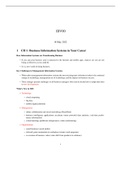Samenvatting
Summary Chapter 1-3-4-5-6 of Accounting & Finance by Ewoud Jansen
- Vak
- Instelling
Chapter 1-3-4-5-6 of Accounting & Finance by Ewoud Jansen Includes the subjects Financial Statements, Time Value of Money, Equity Financing, Debt Financing and Ratio Analysis One part in the summary is not 100% readable so I put it here for you A = Annuity P = Perpetuity S = Sum (single am...
[Meer zien]




